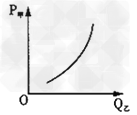问题
选择题
甲商品价格(P甲)与乙商品需求量(Q乙)之间存在如下图所示关系。在其他条件不变的情况下,下列判断正确的是 [ ]

①甲商品的需求量受乙商品价格的影响
②甲商品价格上升会使乙商品价格下降
③甲商品价值量降低时,人们对乙商品的需求增加
④人们的某一特定需要,甲乙两种商品都可以满足
A、①②
B、①④
C、②③
D、③④
答案
答案:B
甲商品价格(P甲)与乙商品需求量(Q乙)之间存在如下图所示关系。在其他条件不变的情况下,下列判断正确的是 [ ]

①甲商品的需求量受乙商品价格的影响
②甲商品价格上升会使乙商品价格下降
③甲商品价值量降低时,人们对乙商品的需求增加
④人们的某一特定需要,甲乙两种商品都可以满足
A、①②
B、①④
C、②③
D、③④
答案:B
Questions 23-28
· Read the Chairman’s Statement below.
· For questions (23-28), choose the correct answer.
· Mark one letter (A, B or C) on your Answer Sheet.
| Chairman’s Statement Despite the appearance of a new competitor on the market, the company continued to grow and increase its market share throughout 2000. Partly in response to this new threat, but more importantly, as part of a strategy for growth, several key decisions were taken this year. The most significant new developments included a range of vitamin-rich drinks for children and low calorie diet drinks, which both proved very popular. The company is still best known for its range of refreshing fruit drinks and, not surprisingly, these were our biggest sellers once more. There were two new additions to the range last year, Squish! and Liquid Sunshine, both of which have a distinctive Caribbean flavour. The first sales figures suggest that our expensive TV advertising campaign was very successful and that these products will soon be as popular as the rest of the fruit drink range. Growth in the keep-fit and health markets meant our energy drinks did well in 2000. Sales of one brand, Booster were second only to fruit drinks in April. The strength of this particular market also explains the success of our new diet drinks. There were, however, big differences in the performance of our older products. The company’s oldest product, mineral water, continued to enjoy a healthy share of a very profitable mass market. It seems our customers are still happy to stay with the brand despite the increasing number of competitors’ products. Unfortunately, the same cannot be said of our Ice-T and Chocomania drinks. Sales showed an initial increase in the summer after we re-launched both products but customers soon bought other brands and total annual sales for both product ranges were disappointing. The company also said goodbye to its own brand of cola, launched in 1998. After two unsuccessful years of trying to break into the huge cola market, 2000 looked like being another poor year. The company finally accepted that it had made a wrong decision and stopped production in September of that year. |
The best selling drinks in April were
A.
| A. energy drinks. |
B.
| B. fruit drinks. |
C.
| C. diet drinks. |